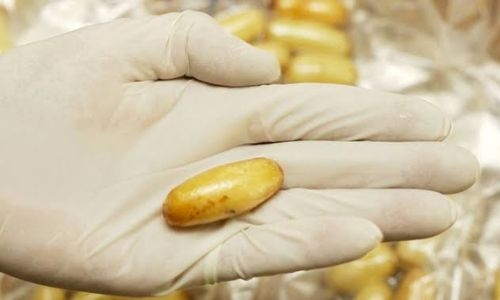
A man arrested from the Bahrain International Airport for attempting to smuggle heroin-filled capsules by swallowing them will now serve a life term in a Bahraini jail. The man, an Asian national, had confessed to interrogators that he was working as a drug carrier in return for BD161 or 90,000 Pakistani rupees. He swallowed the capsules stuffed with drugs before boarding a plane to Bahrain. However, customs officers who grew suspicious of the man’s behaviour during checkin busted the smuggling attempt.
Officers told the court that the man was in an abnormal condition when they spotted him. “We checked him but found nothing. Hence, we escorted him to the red lane, for he was also abnormal in his behaviour.” “From there, an officer searched his baggage but failed to spot anything suspicious. “So, we took him for an x-ray examination, which revealed the capsules in his stomach.”
“During the examination, the man complained of nausea and requested to use the washroom, to which an officer escorted him. “He said he was experiencing an unsettled feeling in his stomach with an urge to vomit.
“This, however, also resulted in him vomiting around 25 capsules,” the officer who arrested the man told prosecutors. “Following the incident, we took him to the Salmaniya Medical Complex, where doctors recovered another 50 capsules from his stomach.” Later, he also confessed to interrogators that he was part of an international network specialised in smuggling drugs.
Public Prosecution had charged him with smuggling drugs into the Kingdom. Tribune recently reported several cases where police arrested suspects for carrying drug-filled capsules in their stomachs. In the latest incident, High Criminal Court in Bahrain awarded a life term to a man for attempting to smuggle 110 drug capsules.
He had also landed in Bahrain from Pakistan. And in a similar incident reported earlier, the High Appeals Court had confirmed a fiveyear jail term awarded to a man caught smuggling more than 100 drug capsules in his stomach.
This suspect also landed in police custody at the Bahrain International Airport after customs officers, who grew suspicious of his behaviour, subjected him to further checks and medical scans.
Experts, however, caution these acts as incredibly risky because the package people swallow can burst at any moment, causing death from overdose. They say that if someone swallows such capsules, there is mostly only one way for it to come out. Reportedly, most carriers also take a drug called Loperamide for diarrhoea to avoid passing the drugs during flight. To bring it out, doctors give laxatives that could make the bowel squeeze more strongly. Afterwards, some poor souls have to go through whatever passed out.
Human couriers
A UN report says that many victims of human trafficking are used to ferry drugs across international borders. Popularly known as ‘drug mules’, the victims are made to swallow balloons containing illicit drugs and are then transported across borders.
Once they have reached their destination, these balloons are retrieved from the victim’s body. The balloons are made with multilayered condoms and are often force-fed to the victim. The traffickers use a special machine to open the condom and put drugs into it. On many occasions, the drug mules are first given a soup laced with drugs to numb their throats.
The soup is very oily and makes the balloons slide down their throat. The victim’s mouth can also be sprayed with anaesthesia, enabling them to swallow up to 120 balloons. A drug mule may be forced to swallow up to one kg of illicit drugs and this painful procedure can lead to serious injuries to the throat.
During the journey, they are given medication to inhibit bowel movement. Once they have reached their destination, they are fed laxatives and the balloons pass through their bodies. This medically dangerous way of transporting drugs can lead and has led to the death of persons, says the UN report.
